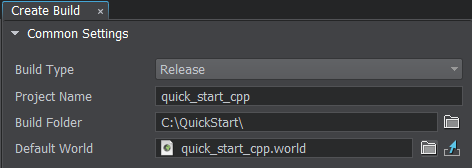Packing a Final Build for Publishing
Before your project can be distributed to users, it must be properly built. To build a C++ Component System project, all components should be compiled successfully.
Step 1. Build the Game#
Packing a final build ensures that all content and code, including all necessary libraries, is up to date, in the proper format, and placed to a proper location to run on the desired target platform.
-
In your IDE set the configuration of the solution to Release and compile the executable for the project.

- Switch to the UnigineEditor. To assemble the project, choose File->Create Build. The Create Build window will open.
-
In the Create Build window, set the Build Type to Release. Set the name to be quick_start_cpp and specify the output folder in the Build Folder field. Make sure the Default World is set to your game world.

-
In the Release App field of the Launcher Default Settings section, set the path to the executable you have just compiled (the default output path in Visual Studio is set to <my_project>/bin/<my_app>_x64).

-
Click the green Create Build button at the bottom of the Create Build window. The assembling progress bar will appear indicating the status of the build process.

Step 2. Launch the Game#
- Upon completion of the build process, the output folder will be automatically opened. To play the game, launch quick_start_cpp.exe.
-
In the Unigine launcher, specify the resolution and the window mode.

- Click Run to launch the standalone application and play the game.
Congratulations, you've made your first project! You may now expand upon it and implement more features.